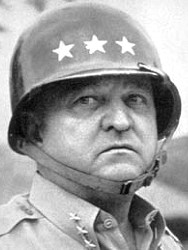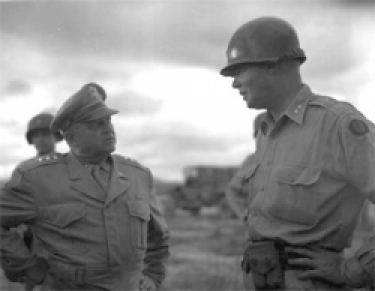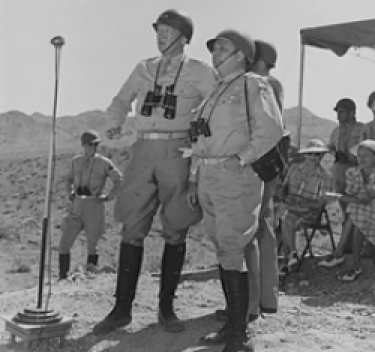
 |
|
|
||
|
Walton Harris Walker 'Bulldog' |
||||
|
Graduate, U.S. Military Academy, Class of 1912 Engagements: • Philippine-American War (1899 - 1902) |
||||
| Biography: | ||||
|
Walton Harris Walker Walton Harris Walker was born on 3 December 1889 in Belton, TX. Military Career Walker graduated from the U.S. Military Academy with the Class of 1912. As a Lieutenant, he served in the Veracruz expedition under Brigadier General Frederick Funston. Patrolling on the U.S.-Mexican border in 1916, 1LT Walker developed a close friendship with Dwight Eisenhower. During World War I, Lieutenant Colonel Walker fought in France with the 13th Machine Gun Battalion, 5th Infantry Division and was twice awarded the Silver Star for gallantry in action. After World War I, Major Walker rotated through a variety of assignments, including service in China; attending the Command and General Staff School at Fort Leavenworth, KS; and teaching duties in several posts, including West Point. In the 1930s he served as executive officer of an infantry brigade commanded by George C. Marshall, the future Army Chief of Staff. World War II When hostilities broke out in Europe in 1939, LTC Walker was executive of the War Plans Division of the General Staff. But when Marshall (then Chief of Staff) assigned George S. Patton to organize America's armored forces, Walker successfully lobbied Marshall for a post as one of Patton's subordinate commanders. He gained a promotion to Brigadier General in the process. Promoted to temporary Major General on 16 February 1942, he commanded Third Armored Division and eventually XX Corps. He took XX Corps to England in early 1944 and led it into combat in Normandy in July as part of Patton's Third Army. Walker's XX Corps played a role in Patton's dash across France in August and early-September 1944, earning the sobriquet "Ghost Corps" for the speed of its advance. Walker's troops saw heavy fighting in France and Germany during the remainder of the war, especially at Metz, the Battle of the Bulge, and in the invasion of Germany. In the spring of 1945, XX Corps liberated Buchenwald concentration camp then pushed south and east, eventually reaching Linz, Austria by May. Walker received the third star of a Lieutenant General on 26 April 1945. Post-World War II After the war, Walker became commander of Fifth Army, headquartered in Chicago, but in 1948 he was assigned as Commanding General of the Eighth Army, the American occupation force in Japan. Walker was ordered by General Douglas MacArthur, the Supreme Allied Commander in Japan, to restore the depleted Army to combat-worthy condition. Shortly after the North Korean invasion of South Korea in June 1950, the Eighth Army was ordered to intervene and drive the invaders back across the 38th parallel, the border between the two countries. With only four lightly-equipped and poorly-trained divisions, Walker began landing troops on the southeast side of the Korean peninsula in July. After his lead units, elements of the 24th Infantry Division (including the ill-fated Task Force Smith), were virtually destroyed in a few days of furious fighting between Osan and Taejon, Walker realized his assigned mission was impossible and went on the defensive. Pushed steadily back towards the southeast by the North Korean advance, Walker's forces suffered heavy losses and, for a time, were unable to form a defensible front, even after bringing the 1st Cavalry and 25th Infantry Divisions into the fight. Walker's situation was not helped by MacArthur's unrealistic demands from Tokyo "not to retreat an inch." Attempting to obey, Walker gave a bombastic "not a step back" speech to his staff and subordinate commanders that did not go over well. Nor did it stop the North Koreans from pushing back even further, the Americans and the Republic of Korea Army (ROK) that had been badly mauled in the opening days of the invasion. As American and ROK forces retreated further east and south, they finally arrived at a defensible line on the Nakdong River. They took advantage of shortened supply routes and a relatively good road network to exploit the advantages of "interior lines." Walker was able to quickly shift his units from point to point, stopping North Korean attacks before they could be reinforced. The Americans were greatly aided by decoded radio intercepts of enemy communications, giving them advance knowledge of where North Korean attacks would occur. Walker was also able to employ artillery and airpower to great effect. American forces gradually solidified this defensive position on the southeast side of the Korean peninsula, dubbed the "Pusan Perimeter." Walker received reinforcements, including the Provisional Marine Brigade, which he used along with the Army's 27th Infantry Regiment as "fire brigades;" reliable troops who specialized in counterattacking and wiping out enemy penetrations. As more reinforcements arrived, the combat advantage shifted toward the American and South Korean forces. North Korean forces had suffered terribly and their supply lines were under constant aerial bombardment. Almost all of their T-34 tanks, which spearheaded the invasion, had been destroyed. Walker ordered local counterattacks while planning for a large scale breakout in conjunction with MacArthur's Inchon landing in September. With MacArthur's amphibious flanking move, the North Koreans seemed trapped but Walker's rapid advance northwest towards Inchon and Seoul emphasized speed over maneuver and made no attempt to encircle and destroy the North Koreans after punching through their lines. Although thousands of prisoners were taken, many North Korean units successfully disengaged from the fighting, melting away into the interior of South Korea where they would conduct a guerrilla war for two years. Others escaped all the way back to North Korea. With the war apparently won, Walker's Eighth Army quickly moved north and, with the independent X Corps on its right, crossed the 38th parallel to occupy North Korea. Fighting tapered off to sporadic, sharp clashes with remnants of North Korean forces. By late October 1950, the Eighth Army was nearing the Yalu River, North Korea's border with China. Informed by MacArthur's headquarters that the Chinese would not intervene, Walker did not ensure that his troops maintained watchful security. Due to a lack of coordination between Walker, General Edward Almond, Commander of the X Corps, and MacArthur's headquarters in Tokyo, a gap had opened between Eighth Army and X Corps as they moved close to the Chinese border. Eventually, the weather had turned savagely cold, and most American units had no training and inadequate equipment for the bitter temperatures. Contrary to MacArthur's expectations, the Chinese intervened in force; first in a series of ambushes, then in sporadic night attacks, and finally in an all-out offensive in which large Chinese forces infiltrated the lines, taking advantage of the American failure to take basic security measures, and the large intervals between American and South Korean units and between the Eighth Army and the X Corps. From late October until the beginning of December 1950, the Chinese killed or captured thousands of American and ROK soldiers, decimating the 2nd Infantry Division and forcing Walker into a desperate retreat. Using his superior mobility, Walker successfully broke contact with the Chinese by early December, withdrawing south to a position around Pyongyang, the North Korean capital. Without instructions from MacArthur's headquarters, Walker decided that Eighth Army was too battered to defend Pyongyang and ordered the retreat to continue to below the 38th parallel. Medals and Awards Distinguished Service Cross with Bronze Oak Leaf Cluster Distinguished Service Cross Citation (1st of 2 Awards) The President of the United States of America, authorized by Act of Congress, July 9, 1918, takes pleasure in presenting the Distinguished Service Cross to Major General Walton Harris Walker (ASN: 0-3405), United States Army, for extraordinary heroism in connection with military operations against an armed enemy of the United States. On 23 August 1944, Maj General Walker, Commanding General, XX United States Army Corps, with complete disregard for his own safety, personally directed the successful operation which established a bridgehead across the Seine River near Melun, France. By his continuous presence with the forward elements of his command, as well as exemplary judgment and leadership, he inspired his command in effecting an early crossing of the Seine River and the continuance of the attack eastward. General Walker's contact with the forward combat troops was maintained in the face of heavy enemy fire. He repeatedly exposed himself to this enemy fire, encouraging the troops to move forward and by doing so gave them the required confidence to continue their advance. When certain elements were halted by intense enemy fire, he courageously assumed personal command and through his own supervision, force and persuasion, although he himself was in complete view of the enemy, caused the troops to effect the crossing of the river. By his intrepid direction, heroic leadership and superior tactical knowledge and ability, General Walker set an inspiring example for his command, reflecting the highest traditions of the armed forces. General Orders: Headquarters, Third U.S. Army, General Orders No. 54 (September 9, 1944) Distinguished Service Cross Citation (2nd of 2 Awards) The President of the United States of America, under the provisions of the Act of Congress approved July 9, 1918, takes pleasure in presenting a Bronze Oak Leaf Cluster in lieu of a Second Award of the Distinguished Service Cross to Lieutenant General Walton Harris Walker (ASN: 0-3405), United States Army, for extraordinary heroism in connection with military operations against an armed enemy of the United Nations while serving as Commanding General of the 8th United States Army. Lieutenant General Walker distinguished himself by extraordinary heroism in action against enemy aggressor forces in the Republic of Korea from 14 July to 28 September 1950. During this campaign General Walker personally, and at great risk to his own life from enemy ground fire, performed repeated aerial reconnaissance flights in unarmed planes deep into enemy territory. The knowledge gained by General Walker from these flights was of inestimable value to him in making tactical decisions, and contributed greatly to the accomplishment of his mission in spite of the preponderance of force possessed by the enemy. In addition to the above and with personal disregard not only of health but of life itself, he spent hour after hour and day after day on the battlefield, inspiring the United Nations forces with his own courage and his will to fight. Where acts of personal courage were common, General Walker's fearlessness and courageous leadership were outstanding. General Orders: General Headquarters Far East Command: General Orders No. 33 (October 1, 1950) Honors by Korea ● In 1963, South Korea President Park Chung-hee honored the general by naming a hill in the southern part of Seoul after Walker. Today, Walker Hill is the site of the Sheraton Walker Hill, a five-star international resort and hotel. Honors by Others General Walker's memory was much honored in the years immediately following the Korean War. ● The Army chose his name (and his other nickname), for its next light tank, the M41 Walker Bulldog. Death and Burial As Lieutenant General Walton Harris Walker inspected positions north of Seoul on 23 December 1950, he was killed in a traffic accident when his command jeep collided with a civilian truck at high speed. Walker's body was escorted back to the U.S. by his son, (future general) Sam S. Walker. On 2 January 1951, Walton H. Walker was posthumously promoted to four-star General on the same day he was buried at Arlington National Cemetery in Arlington, VA. His grave is located in Section 34, Site 86-A. In Summary General Walton H. Walker was a great and noble soldier. He was a man of enormous personal and professional courage and, although his physical height was only five-feet, five-inches, he possessed a rare stature. Like most short people, Walker had to work twice as hard just to get half the recognition. And, like Thomas Edison, he believed that genius was one percent inspiration and ninety-nine percent perspiration. Others of his era may have been more articulate, more photogenic, and more charismatic, but none was a better combat commander. With his passing, the nation lost a faithful soldier. The Army lost a great commander. |
||||
| Origin of Nickname/Handle: | ||||
|
Walton H. Walker was given the nickname "Johnny Walker" by his classmates at the U.S. Military Academy.
It was General George Patton who gave Walker his second nickname. Watching Walker on the parade ground one day, Patton remarked that Walker's determined jaw and short, powerful build made him look exactly like a bulldog and the name stuck. From then on, he was referred to as "Bulldog" Walker. |
||||
| Honoree ID: 353 | Created by: MHOH | |||
Ribbons
Medals
Badges
Honoree Photos
 |  |  |
 |  |
 |


